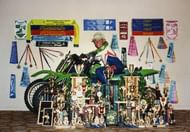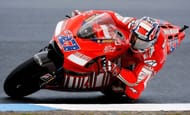The notoriously unforgiving world of MotoGP has destroyed the world championship dreams of hundreds, with only 25 riders claiming the championship in a history spanning more than 60 years.
In the mid 2000s, this cut-throat environment bore witness to a rider who captured the imagination of all with his enigmatic riding style, dominated the sport and then left it on his own terms, not succumbing to the insurmountable fame and worldly pleasures which become routine for those who conquer this sport. This perfectly encapsulates the racing endeavors of Casey Stoner, two-time MotoGP World Champion.
With the Australian celebrating his 30th birthday today and enjoying his post-retirement life, here is a brief look at the champ’s eventful motorcycle racing career.
“To be frank: Casey Stoner is the fastest man I've ever seen on two wheels.”
These were the words spoken by veteran commentator Steve Parrish in regard to the Australian, who, in 2012, at only 26 years old, was leaving the sport while still at its summit.
Indeed, in his 11 years in Motorcycle racing, of which 7 were in MotoGP, he was able to achieve several phenomenal feats. He had such immense self-belief and talent that given any kind of bike, he could still go fast. Usually, riders take around 3-4 laps to get accustomed to the machinery and the way the bike behaves, but Stoner had the ability to go fast on the first lap itself.
Born in Southport, Australia, Stoner caught racing fever early on in his life when at the age of 4, he participated in a dirt track race. In Australia, he championed the dirt track racing scene, clinching every championship which could be won at his age.
His supreme talent and relentless love towards racing was showcased more clearly; when aged 12 he contested in 5 different categories of dirt track races consisting of 35 races during a single weekend and won 32 of them. His unique riding style of sliding sideways during a corner which would later garner him unprecedented success in MotoGP originated through these dirt track endeavors.
Seeing his success, it took no time for his parents to decide to leave for Europe to give him a chance to compete with the world’s fastest riders. He excelled in junior championships in Spain and Britain during 2000-01, which also included a few appearances in 125cc class of MotoGP World Championship.
During two further years in the 125cc class, Stoner impressed, especially in 2004, when with the factory KTM team, he finished 5th in the standings, over 60 points ahead of his teammate. The same story continued the following year when he joined 250cc class for Aprilia and finished second in the standings over 100 points ahead of the next Aprilia rider.
Through most of his junior career, Stoner rode for teams run by Lucio Cecchinello, who had so much faith in Stoner’s outstanding talent that he decided to enter his own team in MotoGP by procuring a satellite Honda for the 2006 season. His debut season proved to be a preview of what was to come in the next few years, as in an inferior bike Stoner took pole in just his second race and then went on to finish inside top 5 several times during the season.
2007 proved to be the season when Stoner finally established his name among the greats. For this season, he signed up with Ducati, which had enjoyed moderate success in MotoGP, but were a long way away from being a front-running team; no one expected them to be fighting for podiums, let alone a championship.
But Stoner took the motorcycle racing world by storm when he utterly dominated the season, taking 10 victories and 6 poles to wrap up the title with several races to go. This proved to be the first time in over 30 years that a European manufacturer had dethroned the Japanese dominance and it all proved possible majorly through Stoner’s supreme talent and determination.
2008 proved to be another strong year for him as he took 6 victories and 9 poles, but majorly due to several crashes during the season, it was Valentino Rossi who took the title. In 2009, he again stacked up several wins and podiums, but his season was marred by a mystery illness which resulted in him getting tired easily. Upon diagnosis, it was revealed that he was suffering from lactose intolerance, which would require him to miss the next three races to get the requisite medication.
This effectively put him out of the championship, but still, he came back stronger than ever as he won the next two races, finished second in the penultimate round, before crashing out from pole during the last race of the season. In 2010, with Ducati falling behind consistently in the development race, Stoner only took three victories and that too during the latter half of the season, when Ducati finally managed to get some improvements on the bike.
Ever since winning the championship in 2007, Ducati’s development rate had consistently faded away as showcased by Stoner’s own performances, he took 10 victories in his championship year, and then it decreased to 6, then 4 and finally 3.
Stoner’s capability had not declined, but the bike’s competitiveness had. Moreover, during his four years with the team, none of his teammates succeeded in getting close to the 23 victories he achieved, with Capirossi the only other rider to have won a race with the team and that too a single victory in 2007. The bike had been extremely unrideable with even veterans like Loris Capirossi and Nicky Hayden unable to master it. Hayden later went on to express that “In 2009 when I first got on the bike, I couldn’t believe how Casey could go so fast with it, Casey had extreme talent.”
Stoner’s spectacular results in the Ducati stand out even more when we compare his results with the nine times champion Valentino Rossi, who spent two years with the Italian team from 2011-12. Rossi perished during this period as he could only secure three podium finishes before leaving the team for good to rejoin Yamaha. Later, describing Stoner’s stint at Ducati, the Italian heaped praises on him, saying:
"Stoner did an amazing job at Ducati, when I looked back at his telemetry I used to wonder how he’d achieve such times!... I immediately realised the bike wasn’t the best.”
“I’m certain that, was Stoner to climb onto (Andrea) Dovizioso’s Ducati tomorrow, he’d still manage to finish a race in sixth place. He used to ride in an incredible way. He’s unique.”
His riding style was indeed unique. While most riders rode smoothly around a track, Stoner on the other hand courtesy his dirt track years mastered a new style of shaking and sliding the bike sideways with incredible efficiency. Not only did this style provide him victories, but it also benefitted MotoGP as it was a jaw dropping experience for spectators to witness him drifting effortlessly on the track.
While Rossi was struggling in the Ducati, Stoner got back to his best after finally getting the best bike on the grid – the Repsol Honda or the factory Honda that is. Watching him in 2011, felt almost like 2007 as he again entirely demolished his opposition and took 10 victories, 16 podiums and 11 poles through the year. Then coincidentally on his 26th birthday, he clinched his second world title after winning his home race at Phillip Island, Australia.
Stoner began the 2012 season spectacularly taking two wins and a third place in the first three races. But before the fourth round of the season in France, he absolutely shocked everyone when he made the announcement of retiring at the end of the season, citing losing interest towards competing in the series as one of the major reasons towards making this decision.
In his MotoGP career, Stoner had revealed several times that he didn’t enjoy the interviews and the PR stuff which the riders had to go through and ruled the previous era to be better, he stated “back in those days, it was just racing – Doohan, Rainey, Schwantz, Gardner, Lawson – not half as much bullshit as now. That was the life."
This facet of the sport was also complained by other riders, but not as staunchly as Stoner. Another possible reason, although not explicitly stated by him could be problems with the way Dorna, the owners of MotoGP run the sport, and, according to him, their consistent favouring of Valentino Rossi. When Stoner announced his retirement from the sport, instead of highlighting this, the headline on the sport’s official website read “Rossi to race for two more years”.
Other possible reasons could be the lack of appreciation from fans all through his career, in addition to which he was not recognised much by his rivals, who after his 2007 championship, accorded the success to better Bridgestone tyres instead of his talent. Finally, Stoner had discovered a newfound love for four wheel racing. These appear to be among several reasons behind his shock decision to retire while still at the peak of his career.
Since the announcement, Stoner continued his efforts to win another title, but at Indianapolis, he crashed heavily during qualifying and had to undergo surgery on his ankle, due to which he had to sit out for the next three races, thus essentially ending his title bid for the season. Then, he made an emphatic return and rounded off the final four rounds of his career, taking in two victories including one at home and a third place finish at Valencia, the final race of his career.
The phenomenal pace and style which Stoner had will perhaps never be matched by anyone else, in addition to that his impressive record of 38 victories, 39 poles and 69 podiums stands out even more when we take into account that he managed to pull-off such a stellar record during just 7 years in the sport. Thus, it comes as a no-brainer that had he continued his career, then quite possibly he would have ended up as the greatest rider of all time.
Had Stoner been around in the 1980s and 90s his domination could have been a lot greater as perhaps that environment suited his personality more than today’s hectic era. Whatever maybe the case, but this fact cannot be discarded that he was the fastest rider of his generation and his abrupt departure from the sport has left a void which will never be fulfilled.



